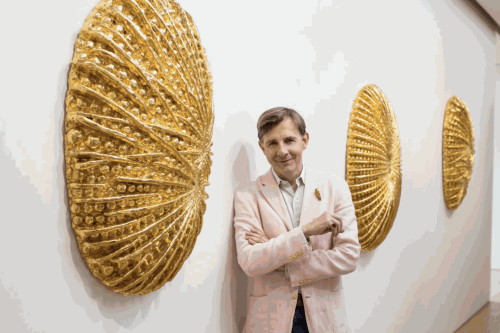Johan Creten has been recognized as one of the pioneers who pushed the confines of contemporary art with ceramics since the late 1980s. His decision to work with clay, a material considered a “taboo” in the art world at the time, was not solely driven by aesthetic concerns; his works carry socio-political meanings and address universal themes such as illness, death, love, and freedom. His ceramic sculptures convey a timeless message while offering a perspective that challenges established norms in art history. Being invited as a guest artist to prestigious institutions like the Manufacture Nationale de Sèvres and Villa Medici further reinforced his innovative approach and impact on the art world.
In Creten’s practice, the concepts of time, patience, and depth take precedence. Embracing the philosophy of “slow art,” he emphasizes the lengthy processes involved in creating his works. The labor-intensive stages of modeling, drying, firing, and glazing reflect his direct engagement with the production process. By connecting with the primitiveness and natural essence of clay, the artist expresses both a physical and intellectual transformation. His sculptures evoke feelings of sensuality, longing, and a sense of aged authenticity, while also embracing the idea that the material itself will evolve over time. This approach positions his works not merely as visual objects but as narratives that unfold and transform over the years.
Through his art, Johan Creten seeks to transcend what he refers to as the “ceramic ghetto,” aiming to reach a broader audience. Drawing inspiration from the mysteries of nature, the fragility of human history, and the subtext of imagery, his works offer alternative perspectives on issues of gender, identity, and transformation. Describing his creations as “time bombs,” Creten invites viewers to discover unexpected details and experience art beyond conventional boundaries.
Born on July 25, 1963, in Sint-Truiden, Creten began his journey in drawing and sculpture at an early age. He later moved to Ghent to study at the Royal Academy of Fine Arts. His selected solo exhibitions include Villa Medici (Italy), CRAC/Regional Contemporary Art Centre (France), Château de Pommard (France), The Monaco Project for the Arts (Monaco), and Middelheim Museum/Sculpture Park (Belgium). His works are also featured in significant public and private collections such as the Bass Museum of Art (USA), The Kohler Foundation (USA), FRAC/Regional Contemporary Art Fund (France), The FMAC/Local Contemporary Art Fund (France), The Provincial Museum voor Moderne Kunst (Belgium), The Museum Kloster Unser Lieben Frauen (Germany), the Olbricht Collection (Germany), and the Sydney and Walda Besthoff Collection housed within NOMA (USA).
Johan Creten lives and works in Paris.
